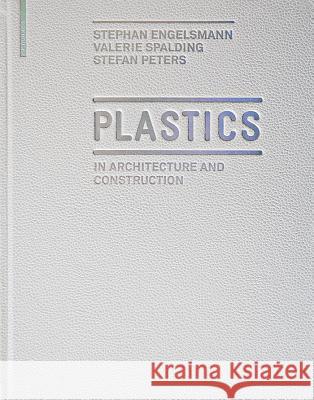Plastics: In Architecture and Construction » książka



Plastics: In Architecture and Construction
ISBN-13: 9783034603225 / Angielski / Twarda / 2010 / 176 str.
Plastics: In Architecture and Construction
ISBN-13: 9783034603225 / Angielski / Twarda / 2010 / 176 str.
(netto: 121,49 VAT: 5%)
Najniższa cena z 30 dni: 127,56
ok. 30 dni roboczych
Bez gwarancji dostawy przed świętami
Darmowa dostawa!
Plastics in architecture: a comprehensive introduction
Glosariusz/słownik
Preface
1 The development of plastic architecture
PRINCIPLES
2 Material properties of plastics
2.1 Forming characteristics and the manufacture of building elements
2.2 Resistance to environmental effects
2.3 Mechanical properties
2.4 Thermal properties
2.5 Flammability and fire performance
2.6 Additives, fillers and reinforcing materials
3. Basics of plastics
3.2 Polymer structure
3.3 The morphology of macromolecules
3.4 The classification of plastics according to their degree of cross-linking
3.5 Synthesising techniques
4. Plastics and their manufacture
4.1 Elastomers
4.2 Thermoplastics
4.2.1 Types
4.2.2 Manufacture
4.2.3 Working methods
4.2.4 Recycling
4.3 Thermosets
4.3.1 Material components
4.3.2 Manufacture
4.3.3 Properties
CONSTRUCTION
5. Finished and semi-finished products
5.1 Solid sheets and panels
5.2 Profiled sheets and panels
5.3 Sandwich panels
5.4 Foams
5.5 Profiles
5.6 Special products
6. Building with plastics
6.1 Thermoplastics
6.1.1 Screwing
6.1.2 Clamping
6.1.3 Bonding
6.1.4 Welding
6.2 Thermosetting plastics
6.2.1 Screwing
6.2.2 Bonding
6.2.3 Dimensioning
6.2.4 Stability and durability
CASE STUDIES
7 Plastics as building envelope
Chanel Mobile Art Pavilion
Hong Kong, China; Tokyo, Japan; New York, USA
BMW Bubble
Frankfurt and Berlin, Germany
Kunsthaus Graz
Graz, Austria
Railway station Emsdetten
Emsdetten, Germany
Idee Workstation
Tokyo, Japan
Reiss Headquarters
London, United Kingdom
Fiberline Composites factory and offices
Middelfart, Denmark
Farben des Konsums
Berlin, Germany
Laban Creekside
London, United Kingdom
Terminal V
Lauterach, Austria
Forum Soft
Yverdon, Switzerland
Polymer Engineering Centre
Melbourne, Australia
Dornier Museum
Friedrichshafen, Germany
Congress centre and auditorium
Badajoz, Spain
8 Plastics as building structure
Plastic tower sculpture
Stuttgart, Germany
D-Tower
Doetinchem, Netherlands
Hoofddorp bus station
Hoofddorp, Netherlands
Roof Yitzhak Rabin Centre
Tel Aviv, Israel
GRP-Glass-Pavilion
Düsseldorf, Germany
9 Plastics as building structure and envelope
Clip-On
Utrecht, Netherlands
Eiertempel
Bern, Switzerland
Five Bubbles
Vienna, Austria
fg 2000
Altenstadt, Germany
Futuro
different locations worldwide
MYKO
Weimar and Rostock, Germany
Novartis Campus reception building
Basel, Switzerland
10 Future developments
High-performance material for supporting structures
High-performance material for building envelopes
Composite materials
Reinforcement of supporting structures
Joining technologies appropriate to the material
New production methods
Technology transfer
Glossary
Bibliography
About the authors
Acknowledgements
Name and building index
Subject index
Illustration credits
Prof. Dr.-Ing. Stephan Engelsmann ist Bauingenieur. Er studierte Bauingenieurwesen an der TU München und Architektur an der University of Bath. Er war wissenschaftlicher Mitarbeiter bei Jörg Schlaich und arbeitete in verschiedenen Ingenieurbüros. Er ist heute Professor für konstruktives Entwerfen und Tragwerkslehre an der Staatlichen Akademie der Bildenden Künste Stuttgart und er ist Gründungspartner im Ingenieurbüro Engelsmann Peters Beratende Ingenieure in Stuttgart.
Valerie Spalding studierte Architektur an der RWTH Aachen. Sie arbeitete in verschiedenen Architekturbüros im In- und Ausland, darunter James Carpenter Design Associates in New York. Seit 2005 ist sie wissenschaftliche Mitarbeiterin an der Staatlichen Akademie der Bildenden Künste Stuttgart und forscht zum Thema Bauen mit Kunststoffen.
Dr.-Ing. Stefan Peters ist Bauingenieur. Er studierte an der Universität Stuttgart und war Mitarbeiter in verschiedenen Ingenieurbüros, unter anderem Werner Sobek Ingenieure. Nach einer Tätigkeit als wissenschaftlicher Mitarbeiter an der Universität Stuttgart bei Jan Knippers von 2000 bis 2006 gründete er mit Stephan Engelsmann das Ingenieurbüro Engelsmann Peters Beratende Ingenieure in Stuttgart.
1997-2025 DolnySlask.com Agencja Internetowa
KrainaKsiazek.PL - Księgarnia Internetowa









